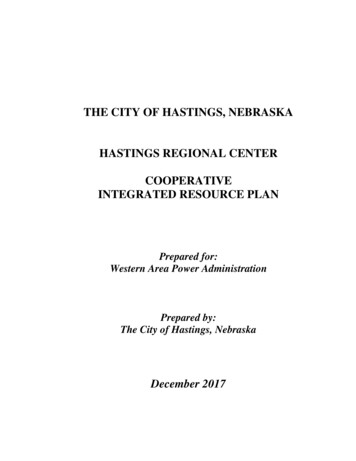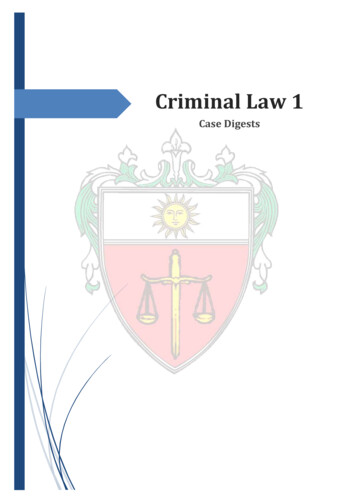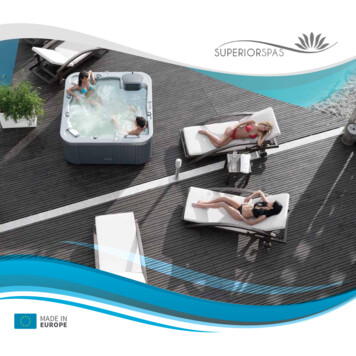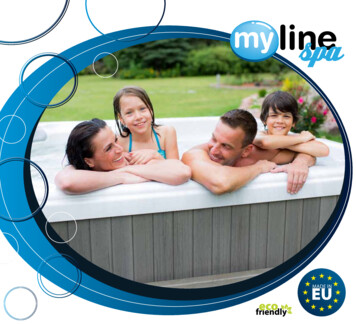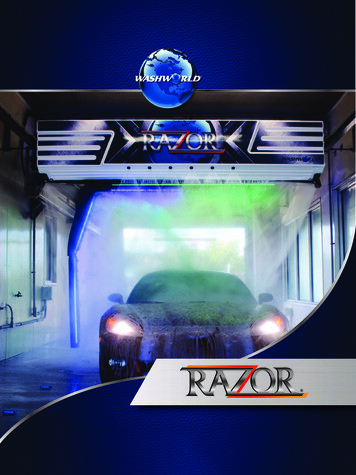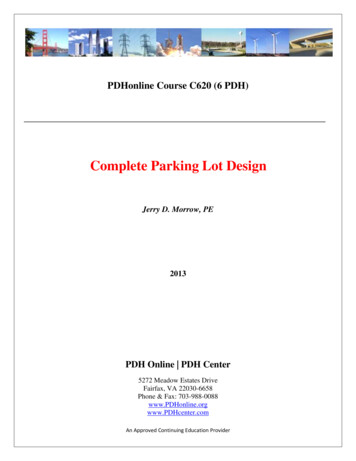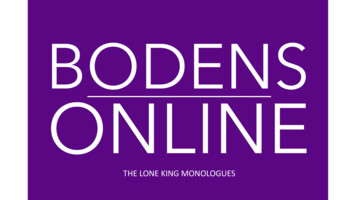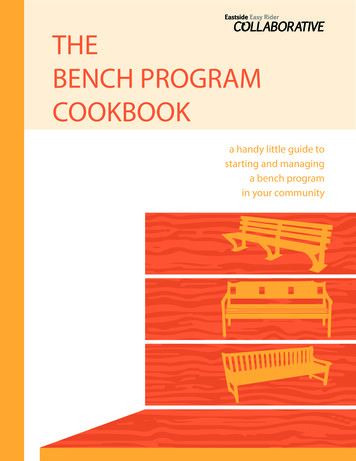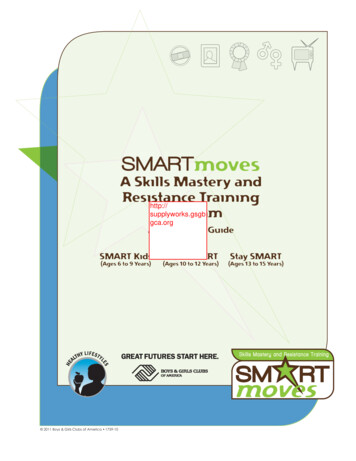
Transcription
SMART movesA Skills Mastery mgca.orgA Facilitator’s GuideSMART Kids(Ages 6 to 9 Years) 2011 Boys & Girls Clubs of America 1759-10Start SMART(Ages 10 to 12 Years)Stay SMART(Ages 13 to 15 Years)
Important Guidelinesfor PhotocopyingLimited permission is granted free of chargeto photocopy all pages of this guide thatare required for use by Boys & Girls Club staffmembers. Only the original manual purchaser/owner may make such photocopies. Under nocircumstances is it permissible to sell or distributeon a commercial basis multiple copies ofmaterial reproduced from this publication.Copyright 2011 Boys & Girls Clubs of AmericaAll rights reserved. Printed in the UnitedStates of America. Except as expresslyprovided above, no part of this book may bereproduced or transmitted in any form or byany means, electronic or mechanical, includingphotocopying, recording, or by any informationstorage and retrieval system, without writtenpermission of the publisher.Boys & Girls Clubs of America1275 Peachtree St. NEAtlanta, GA 30309-3506404-487-5700www.bgca.org
A Facilitator’s GuideSMART Kids(Ages 6 to 9 Years)Start SMART(Ages 10 to 12 Years)Stay SMART(Ages 13 to 15 Years) 2011 Boys & Girls Clubs of America 1759-10
AcknowledgmentsBoys & Girls Clubs of America (BGCA) gratefully acknowledges the contributions of the followingorganizations to the revision of SMART Moves, an important component of our Live Healthy strategy,which gives youth the tools needed to lead long, healthy lives.Twelve Boys & Girls Club organizations nationwide gave their time, resources and expertise to helppilot this important prevention program. The insights and expertise from the following organizationswere invaluable in shaping this program’s content:* Boys & Girls Club of Cheyenne Wyoming* Boys & Girls Clubs of Greater Memphis, Tenn.* Boys & Girls Clubs of Greater Sacramento, Calif.* Boys & Girls Clubs of Green Country, Okla.* Boys & Girls Clubs of Harlingen, Texas* Boys & Girls Clubs of Hartford, Conn.* Boys & Girls Clubs of Metropolitan Phoenix, Ariz.* Boys & Girls Clubs of Portland Metropolitan Area, Ore.* Boys & Girls Clubs of the Midlands, Inc., Neb.* Boys & Girls Clubs of Toledo, Ohio* Children’s Aid Society, N.Y.* Navy MWR Mid Atlantic Boys & Girls Clubs, Va.The following BGCA staff members have been instrumental in the development of SMART Moves:* Judith J. Pickens, Senior Vice President, Program & Youth Development Services* Evan McElroy, Senior Vice President, Marketing & Communications* Kristine Morain, General Counsel, Financial Services* Lorraine Orr, Senior Vice President, Field Services* Romero Brown, Vice President, Program & Youth Development Services* Linda Wiltse, Vice President, Program & Youth Development Services* Felix Rouse, Vice President, Corporate and Partner Relationships* Sharon Hemphill, Senior Director, Health & Life Skills* Lorene Jackson, Senior Director, Government Relations* Karl Kaiser, Senior Director, Creative Services* Tiffany Henderson, Director, Health & Life Skills* Dave Rozman, Director, Teen Services* Lauren H. Taylor, Director, Editorial Projects, Program & Youth Development Services* Patrick Martin, Senior Art Director, Creative Services* Brenda Oliver, Senior Graphic Designer, Creative ServicesBGCA would also like to acknowledge Owens Consulting, Inc and TCC Group for their contributionsand expertise in the development of this curriculum. We also thank Hidden Wholeness for theirtalents and editorial support of SMART Moves.d SMART moves facilitator’s guide
ForewordBoys & Girls Clubs of America (BGCA) is pleased torelease the newly revised SMART Moves program!The SMART (Skills Mastery and Resistance Training) Moves prevention program has receivednationwide acclaim. SMART Moves is one of BGCA’s cornerstone programs. This program helpsyoung people learn about and avoid some of the most immediate threats to their well-being:alcohol, tobacco, other drugs and teen pregnancy.The facts state the need for a program like this: Every day, approximately 4,000 youth ages 12 to 17 try their first cigarette. Some 2,000 youthages 12 to 17 abuse a prescription drug for the first time. Before the age of 13, 25.6 percent of youth report having their first drink of alcohol. Each year, there are approximately 19 million new STD infections, and almost half of themare among youth ages 15 to 24. Pregnancy is one of the primary reasons female students drop out of high school.The SMART Moves program is designed to teach children and teens – through fun, high-yieldactivities – how to abstain from, avoid and resist engaging in risky behaviors. Each component– SMART Kids (ages 6-9); Start SMART (ages 10-12); Stay SMART (ages 13-15) – addresses ageappropriate issues and provides information and skills needed for youth to adopt the attitudes andbehaviors necessary to lead healthy, fulfilling lives.SMART Moves’ comprehensive strategy helps young people better navigate the challenging pathfrom childhood to adulthood. This newly revised curriculum includes updated information aboutsubstance abuse and premature sexual activity, new and dynamic themes, and expanded lists ofresources – all presented in an easy-to-deliver and user-friendly format.In this new millennium, it is more critical than ever to have a positive impact on our youth, andthrough them, on generations to come. As a society, we have no greater resource than ourchildren. The activities and messages of the SMART Moves program are designed to enable youngpeople, especially those who need us most, to reach their full potential as productive, caring,responsible citizens. We are confident that the youth and teens who participate in this program willbe armed with the crucial knowledge needed to have a great future.Roxanne SpillettPresident and CEOBoys & Girls Clubs of AmericaSMART moves facilitator’sguidee
ContentsSMART Moves Facilitator’s GuideIntroduction.1The SMART Moves Experience.3Implementing SMART Moves.5Tips for the SMART Moves Leader.7Using Peer Leaders. 10Getting Started. 11Methods and Strategies for Creating Your Own Activities.12Preparing for a Guest Speaker. 23AppendixGlossary of Terms.26Additional Resources.31Peer Leader Training Guide.33Sample Letter to Caregivers.44Sample Letter to Request Guest Speakers.45Sample Certificates of Completion.48
IntroductionBoys & Girls Clubs of America (BGCA) has a solid track record of creating programs that nurtureyoung people’s self-esteem by instilling in them a sense of belonging, usefulness, influence andcompetence. Clubs do this daily by providing young people with one-on-one relationships withcaring adult professionals and well-rounded programming that is fun and age appropriate.The SMART (Skills Mastery and Resistance Training) Moves program is one such program that has aproven history of success. SMART Moves is a nationally acclaimed prevention program originallydeveloped in the 1980s with help from prevention specialists and Clubs around the country.Since then, the program has been implemented in thousands of Clubs nationwide. This versionincorporates the latest information and approaches that BGCA has learned about effectiveprevention.The SMART Moves program consists of three modules: SMART Kids (Ages 6 to 9 Years) Start SMART (Ages 10 to 12 Years) Stay SMART (Ages 13 to 15 Years)SMART Moves provides: Self-awareness activities to develop respect for one’s own body, ability to handle feelingsand healthy habits; Activities to develop the ability to interact and work in groups; Practice in decision-making, problem solving and goal setting; Age-appropriate information about alcohol, tobacco and other drugs; and Training in refusal techniques useful for avoiding risky situations.Implementing this program in accord with BGCA’s Formula for Impact, a research-based theoryof change that describes how individual Clubs and the Movement as a whole will increase ourimpact – exponentially – on the young people of America. Each element of our Formula for Impactincorporates research into the ways that young people grow and thrive, as well as analysis of thebest practices and traditions of highly effective Clubs.Our Formula for Impact begins with the young people in Clubs. It calls for us to consistently providethe most powerful Club Experience possible – by implementing the Five Key Elements for PositiveYouth Development, offering high-yield activities and providing targeted programs – all of which weknow help youth achieve priority outcomes.1SMART moves facilitator’sguide1
Five Key Elements for Positive Youth DevelopmentThrough extensive research, BGCA has identified certain elements that make it possible for Clubs toassure positive developmental experiences for Club youth. A Safe, Positive Environment: Club staff, facilities, program offerings and age-appropriatesettings create stability, consistency and a sense of physical and emotional safety formembers. The Club provides structure and clearly defines acceptable behaviors. Fun: Clubs generate fun for members. Members develop a strong sense of belongingthrough connections they establish with staff and peers. Staff members make the Club feellike home, fostering a family atmosphere and creating a sense of ownership for members. Supportive Relationships: Club youth develop meaningful relationships with peers andadults. Staff members actively cultivate such relationships to ensure that every member feelsconnected to one or more adults and peers. Staff members demonstrate warmth, caring,appreciation, acceptance and proper guidance in their interactions with members. Opportunities and Expectations: Club youth acquire physical, social, technological, artisticand life skills. Clubs encourage members to develop moral character and behave ethically.Staff members establish and reinforce high expectations and help young people do well inschool and pursue a post-secondary education. Recognition: Clubs recognize and affirm young people’s self-worth and accomplishments.Staff members encourage youth and provide positive reinforcement as they makeimprovements and experience successes. The Club showcases young people’sachievements.Also, because we also know that attending the Club more frequently and over a greater length oftime makes young people more likely to achieve positive outcomes, we must pursue strategies toincrease attendance, program participation and member retention.2Through participation in the SMART Moves program, one of BGCA’s targeted programs, memberswill be exposed to various activities designed to hone their decision-making and critical-thinkingskills, as well as learn how to avoid and/or resist alcohol, tobacco, other drugs and premature sexualbehavior. By giving youth practical applications for learning how to lead a healthy lifestyle, thisprogram positively impacts youth and puts them on the path to a great future.2 SMART moves facilitator’s guide
The SMART MovesExperienceYoung people today face a new world of challenges and opportunities. SMART Moves is aneffective and unique way for Boys & Girls Clubs to help prepare youth to meet these challenges. Itis a creative, fun learning experience that provides girls and boys aged 6 to 15 with the knowledgeand skills they need to grow into confident, healthy young adults.The overriding premise of SMART Moves is to address each age group with an age-appropriateapproach to help members establish who they are. The questions they will examine are thefollowing: Who am I? What do I want to become? What goals do I want to achieve? The approachis a holistic one designed to encompass the whole child. In addressing the physical, cognitive,emotional and social needs and changes in human development in the different age groups,SMART Moves fosters deeper self-awareness and self-confidence in members. It also provides toolsto help youth overcome the obstacles that might impede their development in leading successfullives and achieving their goals.The focus of the sessions is on strengthening positive development and opportunities and puttingmembers in a better position to deal with negative aspects they might encounter, such as peerpressure, experimenting with drugs or engaging in early sexual activity.Primary Goals of the SMART Moves ComponentsThe primary goal of SMART Kids (ages 6 to 9 years) is to provide youth with the knowledge, skills andself-esteem to help them: Make healthy choices and practice healthy behaviors. Avoid risky behaviors and situations, including involvement with alcohol, tobaccoand other drugs.The primary messages of SMART Kids are: Our bodies are priceless and allow us to accomplish our dreams. Young people should avoid risky behaviors and situations, including involvement withalcohol, tobacco and other drugs.The primary goal of Start SMART (ages 10 to 12 years) is to provide young people with theknowledge, skills, self-esteem and peer support to help them: Make healthy choices and practice responsible behaviors. Avoid using alcohol, tobacco and other drugs. Postpone sexual activity and practice abstinence first.SMART moves facilitator’sguide3
The primary messages of Start SMART are: Preteens should not be involved in the use of alcohol, tobacco and other drugs. Besidesbeing illegal, these substances are potentially harmful to bodies and minds that are stilldeveloping. “Responsible use” is not an option.Preteens should postpone sexual involvement and practice abstinence first because that is the bestway for young people to avoid the risks of pregnancy and STIs (sexually transmitted diseases).The primary goal of Stay SMART (ages 13 to 15 years) is to provide young people with theknowledge, skills, self-esteem and peer support to help them: Make healthy choices and practice responsible behaviors. Avoid using alcohol, tobacco and other drugs. Postpone sexual activity.The primary messages of Stay SMART are: Teens, ages 13 to 15, should not be involved in the use of alcohol, tobacco and other drugs.Besides being illegal for teens, these substances are potentially harmful to bodies and mindsthat are still developing. “Responsible use” is not an option. Teenagers should postpone sexual involvement as long as possible because that is the bestway for them to avoid the risks of pregnancy and sexually transmitted diseases. Youth whoare already sexually active can be encouraged to practice abstinence again. For thosewho do not practice abstinence, the program offers accurate information to allow youth toprotect themselves from pregnancy and STIs.4 SMART moves facilitator’s guide
ImplementingSMART MovesBGCA recommends that each age-appropriate module (SMART Kids, Start SMART and Stay SMART)is implemented in its entirety, in sequence, as each session builds upon knowledge and discussionfrom the previous session. Each module consists of a set of sessions, 45 minutes to one hour long.Sessions are grouped into units. Sessions are typically conducted once a week, but Clubs may varytheir schedules to conduct one or more in the course of one week. Sessions are designed to be ledeither by an adult facilitator and/or peer leaders. If peer leaders are leading a session, an adult mustalso always be present.Each module has an Introductory and a Concluding Unit, to be used to: Provide an orientation to the Club members. Administer the Pre-Tests and Post-Tests that will help evaluate the program. Engage members in an age-appropriate ice-breaker that will also serve as a self-esteembuilding activity.Each session includes the following: A Warm-up/Log-in is designed to elicit facts, feelings and opinions related to the topic aswell as set the tone for the session. An Interactive Activity is designed to impart important information and developcommunication and other interpersonal skills through games, role plays and cooperativelearning. A Wrap-up/Reflection is designed to reinforce the main ideas and goals of the session.Each session begins with an essential question or thought-provoking quote that directs the activitiesand ties them together in the wrap-up. All components of the sessions – including Warm-up/Login, Main Activity, and Wrap-up/Reflections – are youth-oriented and experiential to ensure thatmembers fully engage in the various activities. The only exceptions are activities with content thatrequires facts and information as background for progression of the sessions. In this case, staff willfacilitate the presentation of the information through a variety of methods, including brainstorming,handouts and fact sheets, charting and creating lists. Members then use the information and applyit to a variety of engaging activities.All group members will keep a journal during the program. Members will need their journals at eachsession. The journal will be used to respond to the Warm-up/Log-in questions or quotes and Wrapup/Reflection questions during each session. Younger members will have the choice to either drawor write in response to questions. In between sessions, journals should be should be locked andsecured. All members will keep their journals at the end of the program, so they can come awaywith a collection of their thoughts from the program, The purpose of the journal is not to evaluatethe program, but rather to give each member a collection of their insights, feelings and reactions tothe various topics, themes and content of the program.SMART moves facilitator’sguide5
While it is recommended that Clubs implement all units and sessions within the age-appropriatemodules, there are also ways that Clubs can enhance the SMART Moves program for participants.For example, you can supplement the units and sessions with guest speakers, age-appropriatevideos and field trips. In addition, a group leader or facilitator can create additional sessions oractivities for the group by using the methods and strategies described in this Facilitator’s Guide.This flexible, “accordion” style module enables each Club to tailor the program to the needs of itsmembers.SMART Moves Encourages CollaborationSMART Moves is not intended to operate in isolation. BGCA recognizes that young people becomeinvolved in risky behaviors for many reasons. Especially for high-risk youth, it will take many differentorganizations and individuals working together to create healthy environments and encouragehealthy choices. Therefore, we encourage SMART Moves staff to form a prevention team thatinvolves other Club staff, outside agencies, parents and community groups. Some of these mayinclude your local school system, the local health department, Planned Parenthood (or similaragency), the mayor’s office and the American Red Cross.Evaluating the SMART Moves ProgramIn each SMART Moves program module, a participant Pre- and Post-Test is included. As previouslystated, the Pre-Test should be administered at the beginning of the program during the IntroductoryUnit; the Post-Test should be administered at the end of the program during the Concluding Unit.These tests are designed to provide facilitators and Club staff with a way to gauge changes inattitude and knowledge over the course of the program, and to improve program implementationin the future.For those Clubs who wish to engage in a more formal and detailed evaluation of the SMART Movesprogram, BGCA has also created a companion guide for evaluating the SMART Moves program– the SMART Moves Evaluation Guide. This guide provides a common framework for Clubs to usein evaluating SMART Kids, Start SMART and Stay SMART. The evaluation framework will enableorganizations across the Boys & Girls Club Movement to assess the impact of their work and willfacilitate our ability to collectively communicate the impact of SMART Moves to current and futurestakeholders. This guide can be accessed through the SMART Moves Online Community, which isavailable through www.bgca.net; you can also directly go to this URL: ills/SMARTMovesProgram/Pages/default.aspx (you will need your BGCA.net username and password to log in).Please note: Before engaging in any type of formal evaluation of the SMART Moves program, pleaserefer to the SMART Moves Evaluation Guide, which details the types of resources, staffing, proceduresand tools needed to conduct an evaluation with fidelity. BGCA has provided the means for Clubsto conduct evaluations up to a certain level of rigor. If you do wish to conduct a formal, third-partyevaluation of your program, please contact the SMART Moves staff at BGCA for more informationbefore moving forward.6 SMART moves facilitator’s guide
Tips for theSMART Moves Leader Ideally, each module (SMART Kids, Start SMART and Stay SMART) should be implementedin its entirety for participants to receive the full benefit. However, each session also can bepresented as a stand-alone lesson. When implementing the full module, it will help membersto review the prior lesson before beginning the next session. This will take extra time –anywhere from five to 15 minutes – depending on the nature of the previous session. Thereare several ways to review.* You can ask several pointed questions about the main ideas from the last session to seeif members remember the important points. If they do not, you can remind them.* You can ask a more open-ended question such as: Who can tell me what we learned inthe last session? You can debrief with them.* Another option is to have a list of key points/facts on chart paper as they come into theroom and simply go over these with them. Peer leaders are very important. Let them help with sessions whenever they can. They canhelp facilitate role plays and encourage group members to participate in the programand in individual activities. They will add excitement for the younger members. For moreinformation, review the Peer Leader Training section in the Appendix of this guide. Be sensitive to individual differences. For instance, participants who are shy mayneed encouragement to get involved. Youth with disabilities might need specialaccommodations, but do not draw extra attention to their issues. Be aware of the varying reading levels of all members, especially the 6-to-9-year olds. Ina number of the activities, peer leaders can play an important role in moving the activityalong smoothly for non-readers or struggling readers. As a part of some activities, participants are asked to write their responses on a handout. Ifthis proves to be a problem, work with verbal responses. Encourage discussion. Allow participants to talk about their own life experiences andfeelings. Encourage participants to talk to and look at their peers when responding toquestions or making comments, not just the facilitator. Praise participants’ contributions to the discussion, with comments like, “Good idea,”“Right,” “YES!” and nodding in agreement. Establishing routines is extremely important for all age groups, especially for the youngermembers. Members feel more at ease when they know what to expect. Researchshows that young people fare better in structured environments that still allow room forindependent thinking, creativity and self expression. Activities such as Circle Time or theWarm-up/Log-in response to the essential quotes and questions provide a consistent routinewhile allowing for creative response. In role play situations, use the examples as models. If necessary, change the languageor setting to be more appropriate for Club members. Adapt the situations/names tothe cultural make-up of your group. Create other role play situations based on real-lifeexperiences. You or the peer leaders may want to do initial demonstrations of role plays toSMART moves facilitator’sguide7
encourage group members to participate in role playing exercises. You can enhance roleplays with simple props such as a hat, a microphone, a backpack or eyeglasses. In role plays, it is important to set up stage rules before having members perform. Forexample, there should be no physical contact or violence; always have the “actors”communicate with each other before the role plays and debrief afterwards. Avoid havingadults or older peer leaders act as the aggressor in sexual pressure role plays. The goal is toensure that participants safely enter and exit the imagined world. Use guest speakers. Be sure guests understand the philosophy and objectives ofthe program so they can make an informative and fun presentation. Avoid havingformer addicts as speakers. Their testimonials often glamorize problems in the minds ofimpressionable youth, who then assume drug problems can be easily overcome. For moreinformation, review the information about Preparing for a Guest Speaker on page 23 ofthis guide. Be a good listener. Listen to what is said and what is not. The subject matter discussed inSMART Moves may provoke participants to bring up very personal, emotional concernssuch as a substance-abusing parent or experiences of sexual abuse. Know and follow yourClub policies relating to member confidentiality and to disclosure and reporting proceduresregarding child abuse and neglect. Do not encourage participants to say things that might make them uncomfortable or revealprivate matters in the group. Tell members not to use actual names of friends. For instance,when asking about experiences with drugs or alcohol, ask what has happened to “peopleyour age,” “friends” or “your peers” rather than what has happened to “you.” Do not attempt to solve complex personal issues in the small group. You are in a key positionto make an intervention in a child’s life, but follow through with a private meeting. Referyouth to resources you have checked on and whose services you feel confident about.Know your state’s laws, as well as BGCA’s policy on mandatory reporting, in case membersdisclose applicable information (e.g., abuse). The U.S. Department of Health and HumanServices, Administration for Children & Families’ website gives a summary of all states’policies on mandatory reporting. Visit www.childwelfare.gov/systemwide/laws policies. When pairing members or creating small groups for activities, make sure to change the pairsand mix of the groups so that eventually all members have the opportunity to work witheach other. However, certain activities call for varying levels of ability (reading, problemsolving) or maturity. Keep this in mind when forming groups. Use incentives/prizes whenever appropriate. Inexpensive items such as colorful stickers,pencils, and party-favor type toys will go a long way. Also very effective are certificates ofmerit (easily created on the computer), pizza parties, “member of the week,” gift cards orcoupons from local stores. Often, retailers will donate these. Keep it up-to-date and relevant! Make sure data about drug use and teen pregnancyis current. In addition, all articles, media, CDs, DVDs, songs, examples of pop culture andlanguage should be relevant and appropriate for your members. The program providescurrent data, examples of lyrics, articles and suggestions regarding drug facts and role playscenarios, but you know your members and may need to substitute more up-to-date orrelevant material in some sessions.8 SMART moves facilitator’s guide
Regardless of how you enhance the program, however, remember that continuity ofleadership is important. For best results, keep the same program facilitator involvedthroughout all sessions.Keep It Fun! Plan a special kick-off event for participants. For example, hold a party, take a trip orplan some other special event. Involve SMART Moves participants in special activities. Have a pizza party after a session,hold an overnight or retreat or plan a Club-wide event. Plan a recognition night after participants have completed the last session. Inviteparents, other Club members, staff and local personalities to the festivities. Hand outCertificates of Completion. Create your own or use the templates provided in theAppendix of this guide.SMART moves facilitator’sguide9
Using Peer LeadersWhy Peer Leaders Are ImportantThe use of peer leaders is very important. This approach enhances the SMART Moves experience foryounger program participants as well as for peer leaders for many reasons: Youth may gain more from a program led by their peers. Teens who act as peer leaders continue to learn while teaching others. Teens involved in leadership roles continue to stay involved. Teens who are peer leaders feel a greater sense of self-worth.Let peer leaders help with sessions whenever they can. They can help facilitate role plays andencourage group members to participate in the program and in individual activities. They will addexcitement for younge
moves. facilitator's guide. 3. The SMART Moves. Experience. Young people today face a new world of challenges and opportunities. SMART Moves is an effective and unique way for Boys & Girls Clubs to help prepare youth to meet these challenges. It is a creative, fun learning experience that provides girls and boys aged 6 to 15 with the knowledge

